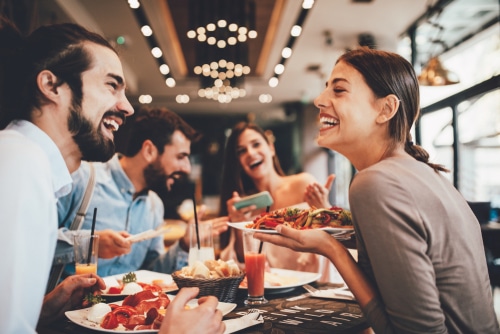You’ve watched Friends a thousand times. After all, you’re practicing your English and what better way than to binge-watch one of America’s favorite all-time sitcoms. Oh, how you wish you could go to a Central Perk and enjoy a slice of American pie with Monica Gellar! Or maybe you’re more into Gilmore Girls, so Luke’s Diner is more your style, especially as you are trying to learn everyday English phrases for going to a restaurant in the USA. Whatever your preference, practice using these everyday English phrases when you go to a restaurant in America and you’ll have even Monica, the perfectionist, saying, “Yes, yes, yeah, yeah, yeah!”
For the sake of these examples we are using a party of four persons. A party is what Americans call a group of people who dine together. We will start with English phrases before arriving at the restaurant, then we’ll give you English phrases while you’re at the restaurant. Finally, we will end with English phrases at the end of your meal. These are very important phrases, as it could mean the difference between you washing lots of pots and being told, “Thank you for coming, do come again!”
English Phrases for Interacting with the Restaurant Before Arrival
It is recommended that you call in advance to make a reservation, if you plan to dine out, especially in a group. So your conversation may go something like this:
- “I would like to book a table for a party of four, please!”
- “I would like to make reservations for four, please? Could you fit us in for 6 o’clock?”
The person on the phone might reply:
- “Sure! What’s your name?”
- “I can’t seat you at 6. Would 6:30 be okay?”
- “Certainly! I can seat you at 6 pm” (if it’s the same day). Or, on Tuesday, Wednesday, etc., depending on availability.
You would be asked:
- “Could you kindly give me your name?”
- “Under whose name should we book the table?”
Pre-meal phrases:
Upon arrival, you would inform the host/hostess:
- “Hello! We’ve booked a table for four.”
To which you would be asked:
- “What’s the name?”
- “Under what name, please?”
- “We have a dinner reservation at 6pm.”
The host would then look at the reservations list to see who is booked for that time. He/She may ask:
- “John Brown’s party?”
- “Are you John Brown?”
Or, you could even say,
- “I booked a table for four for 6 pm under the name John Brown!”
Or if you did not book in advance, you would inform the host of the number of persons in your party in order for the host to bring you to an appropriate table:
- “A table for four, please.”
- “Do you have a table for four free right now?”
- “Hello! We didn’t book a table, but can you fit us in?”
- “We’d like a table for four, please!”
Any of these phrases will work!
Note that a host at a restaurant is usually the person who seats you. He/She usually stands behind a podium or at the entrance, waiting to greet you as you enter the restaurant.
Some restaurants have both tables and booths. A booth is a seating arrangement where there are no individual chairs, and is considered more intimate than a table with two or more chairs.
If this is your preference, you would respond to the aforementioned question by saying,:
- “A booth, please!”
The host will then lead you to your seats with a, “Right this way!”
Based on the night and the patronage, a table may not be ready or is unavailable. So you may hear these phrases:
- “If you wait, there’ll be a table ready for you in about twenty minutes.”
- “We’re fully booked at the moment. However, you can call us in an hour. Here’s our number.”
- “Your table isn’t quite ready. Would you like to wait in the bar?”
- “Can I get you a drink while you’re waiting?”
When the table is ready, the host will then say;
- “Your table is now ready. Please come this way!”
- “Right this way, please!”
English Phrases for Interacting with your Waiter/Waitress/Server
Now that you’ve been assigned a table, you would more than likely be assigned a waiter too. This is the person who will take your order(s) and is also called the server. Due to political correctness (PC), you will more than likely hear the word server instead of waiter/waitress, as it is gender-neutral.
If you’ve been assigned a server (and usually you would know because the host would say something like, “John will be your server tonight”), you would be given a menu.
However, if you have not yet been assigned a server, or if the server did not offer to show you the menu, you would ask:
- “Could I please see a menu?”
- “Could I see a menu, please?”
- “Could I see the wine list, please?”
Usually, the alcoholic and nonalcoholic beverages are listed on the back of the menu, but pricier restaurants will have a separate “wine list.”
Prior to speaking with your server, you may want to speak among yourselves concerning what you would all like to eat. Some phrases that may come up include the following:
- “What are you going to order?”
- “I’m trying to decide between the pork chops and the chicken salad.”
- “I’m thinking about the BLT sandwich.” A BLT sandwich consists of bacon, lettuce and tomato.
- “Do you want to share an appetizer?”
Phrases to place an order:
The first question usually asked by your server is:
- “Can I take your order?”
- “Are you ready to order?”
- “What would you like for a starter?”
- “Anything to drink before I take your order?”
- “Can I start you off with something to drink?”
- “Would you like to start with an appetizer?”
An appetizer is as the word implies: Food to open up your appetite for the main course. E.g. a cup of soup.
If you’re all having appetizers you would reply:
- “Yes, please! We’ll start with an appetizer!”
If not, you could say:
- “No, thank you! We’d rather order the entree.”
The entree is the main course, i.e. the chicken, pork, fish, lobster, etc.
Most restaurants serve what is called a “Special.” A “special” at a restaurant is a dish that isn’t usually on the menu. It’s something the chef offers that day or that week or that month.
So sometimes if you don’t see what the specials are, you’d ask your waiter:
- “Excuse me, are there any specials today?”
Other English phrases you could use include:
- “Do you have any special today?”
- “What’s the soup of the day?”
- “What’s in the special today?”
If you are adventurous and like to try new things, you could ask the server:
- “What’s this dish?” pointing to any particular picture you like.
- “What do you recommend?” Usually, they recommend the chef’s “special.”
- “I’ll have the salad!”
If you’re ordering a salad, expect the follow-up question:
- “What dressing would you like with your salad?”
This would elicit a response such as: “Ranch, please!”
Note: Ranch dressing consists of milk, onion, garlic, pepper, dill, parsley, mayonnaise and sour cream, so if you are allergic to dairy you will want to stay as far away as possible from this dressing. The vinaigrette is a more pleasing alternative.
Other everyday English phrases for placing your order include:
- “I’ll have the chicken!”
- “I would like to order the fried chicken!”
- “How long will the fish take?”
If you ordered steak your server would then ask:
“How would you like your steak?”
To which you would reply:
“I’ll have mine rare, please!” In recent times, for health purposes, restaurants have been reluctant to serve rare steak. More acceptable options include: “Well done,” “Medium,” or “Medium-rare.”
Sometimes there are options for more than one “sides.” A side is the accompanying food for the main course, e.g. the chicken. So sides could include mashed potatoes, rice, french fries, etc.
In these cases, your server may ask:
“Which two sides would you like with your meal?”
You would then respond:
“I’ll have the grilled veggies with the mashed potatoes.”
- Each person would give the server the individual orders. However, if you’re all having the same sides, then you would reply, for example:
“We’ll all have the white rice with grilled vegetables.”
After taking your order, the server will more than likely ask:
- “Is that all?”
- “Would you like anything else?”
To this you would reply:
- “Yes, that’s all!”
- “No, could I also have…” and you add to your order.
Other everyday English phrases that you can use include:
- “Nothing else, thank you!”
- “How long will it take?”
You could also ask the server the following before or after placing the order:
- “Could we have some bread?”
- “Could we have another bottle of wine?”
- “Could we have some water?” The server would probably ask: “Still or sparkling?”
Phrases for food exclusions:
There may be dishes you are unable to eat for religious or allergic reasons. In those cases you could use any of the following everyday English phrases:
- “I’m allergic to dairy!”
- “I’m a vegetarian!” (If you are a person who doesn’t eat meat or fish).
- “I’m a vegan!” (If you are a person who doesn’t eat meat, fish, dairy, poultry or any other animal-based product).
- “I don’t eat meat!”
- “Is it kosher?” (Meals that Jewish persons can eat)
- “Is it halal?” (Meals that Muslims can eat)
At the end of serving the meal your server would more than likely say:
“Enjoy your meal!”
And your response would be:
“Thank you!”
Everyday phrases during a meal:
While the meal is in progress, there are some inconveniences that usually occur, such as the placement of the condiments. Condiments are things like salt and pepper, usually found on a dining table. You could ask your companion(s):
- “Could you pass the salt?”
- “Could you pass me the salt, please?”
- “Could you pass me the ketchup?”
- “Could you pass me another napkin?”
- “Could you pass me the pepper?”
Phrases for problems with the meal
Of course, sometimes things happen, like the food not being prepared to your liking, or getting the wrong meal. In cases like these here are some everyday English phrases:
- “Excuse me. This isn’t what I ordered.”
- “Excuse me, I ordered potatoes, but I got french fries!” While they are both potatoes, one is fried, while the other is usually boiled or broiled.
- “I’m sorry, but this food’s cold!”
- “We’ve been waiting for a long time.”
- “Will our food be long?”
- “I’m sorry, but the steak is over done. I ordered a medium.”
You could even ask to speak to the supervisor by asking:
“May I speak to your manager, please?”
At this point the host would say any of the following:
- “Oh my! We’re truly sorry. Let me get you a new plate!”
- “I’m so sorry. Please tell me. What did you order?”
- “I’m sorry, sir/madam: Let me change it for you!”
- “Would you like me to get you something else?”
Usually, the server would visit the table in advance to enquire about the meal by asking:
- “How Is everything?”
- “Does everything taste good?”
This would be your time to give positive or negative feedback. If the feedback is negative, the server may even suggest:
- “Would you like to speak to a manager?”
- “I’ll get the manager for you!”
If the food is satisfactory and you have made it to the last course, your server may ask:
- “Would you like some coffee?”
- “Would you like dessert?”
- “What would you like for dessert?”
- “Would you like to try our dessert special?”
- “Would you like to see our dessert menu?”
Or you could ask:
- “Could I see the dessert menu, please?”
- “Do you have a dessert menu?”
If you’re not interested in dessert at that time, you could respond with any of the following:
- “No, thanks! We’re full.”
- “Just some more water, please!”
- “Could we have four coffees instead?”
- “We’re not quite ready. Would you mind coming back later?”
English Phrases at the End of the Meal
At the successful completion of the meal, you would like to go, but not before settling or complimenting the chef.
Your server will more than likely ask again before presenting the bill:
- “Was everything alright?”
To this you would reply:
- “Yes, everything was delicious!”
- “Our compliments to the chef!”
- “The meal was delicious!”
- “We really enjoyed our meals!”
- “What a wonderful dinner! Compliments to the chef!”
- “The steaks were done to perfection. Our compliments to the chef!”
- “The devil’s cake was to die for!”
Now that you have dispensed with the pleasantries, you can then ask to be shown the bill, i.e. if it has not been already given to you. It is customary for the server to bring the bill to your table even before you ask for it.
In the USA, you usually ask for the check, not the “bill” as you would in Britain. Both mean the same thing of course!
So in the USA you will commonly hear:
- “Check, please!”
- “Could we get the check, please?”
- “Could we pay now, please?”
The server may then want to know how you plan to pay. I.e. via credit card or cash. Also, “Will you be paying together or separately?”
You may choose to pay the bill alone, or split the bill. If you are paying for the group you may tell them:
- “I’ve got this!”
- “This ones on me!”
In America, it is common to go “Dutch.” To go Dutch means to get separate checks and pay for your own things. It is also used to mean splitting the bill in half when on a date. The advantage of going Dutch is that you can all pay separately just for what you yourself ordered, and you won’t have to worry about owing each other money or individually calculating a huge bill. So you would say to your server:
- “Can we have separate checks, please?”
- “Can we pay separately?”
- “We’re going to split the check!”
How you plan to pay is also important as sometimes you may not have sufficient cash in your wallet/purse. You would then ask the server:
- “Can I pay by card?”
- “Do you take credit cards?”
Hopefully, the card did not decline and the host gives you a happy smile. You got the green light to come again.
So there you have it. Some everyday English phrases for going to a restaurant in the USA. Visit 7ESL for more English phrases for going to the restaurant. You can also visit Fluentu to watch videos with interactive subtitles of real scenes in restaurants. If you hover your mouse over a word, you will see the definition, part of speech and the associated image for that word. We love that that you can turn off the subtitles and challenge yourself to see if you can understand and follow along with what’s happening in the video.
If you enjoyed this blog and would like more free English language tips, join our mailing list and have them sent directly to your email.
Have you learned an English phrase for going to the restaurant that is not listed here? Share it with us in the comments box below!





